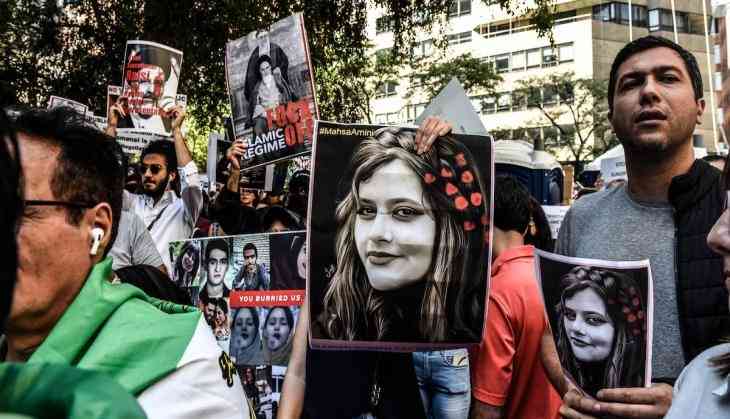Iran: Mass protests over death of Mahsa Amini may assume dimensions of social uprising

For more than a week, mass protests are being held in more than 80 towns and cities across the 31 provinces of Iran over the death of a 22-year-old Kurdish woman called Mahsa Amini, who died shortly after she was arrested by the hated morality police of the Theocratic regime. At least 41 people, including members of the security forces, were so far killed in clashes between protesters and anti-riot police and militia in escalating street violence which may rapidly assume the dimensions of a social uprising.
Mahsa Amini was arrested on September 13 as she was leaving a Tehran metro station with her brother and other relatives. She was arrested along with other women whose clothes did not comply with state regulations and taken away in a morality police van. Mahsa was in a coma for three days, then died "of natural causes," as the authorities claim, but according to activists, the cause of her death was a fatal blow to the head.
The incident unleashed huge anger among ordinary Iranians, who find it extremely difficult to make ends meet, living under international sanctions, without seeing any visible sign of improvement in the economy of the country, which is badly mismanaged. Many Iranians realize that they have less and less to lose and feel strongly repressed by the strict rules imposed by the Iranian regime.
Women in Iran are even more repressed as they must obey a strict dress code or risk being arrested and ill-treated by the morality police, known as Gasht-e Ershad, which means Islamic Guidance Patrol.
The regulations mandate that women cover their hair, usually with a headscarf known as a hijab, and wear clothing that is loose-fitting and does not expose their chests. To enter some mosques, women are required to wear chadors - a large piece of cloth that leaves only the face or the eyes visible.
Once more, following the death of Mahsa, women in Iran are at the forefront of the current protests, as they did back in 2009 during the Green Movement protests that demanded the removal of Mahmoud Ahmadinejad from office when hundreds were arrested and many died, and the brutally suppressed protests in November 2019 when the government ordered a 50 per cent increase in the subsidized price of gasoline. It is estimated that more than 1500 people were killed during the gasoline protests.
After Mahsa Amina's death, some women publicly cut their hair and burned their headscarves, in defiance of the Iranian authorities. Immediately, Mahsa became a symbol of the protest movement.
The incident has triggered angry protests not only by women but also by hundreds of thousands of men who had a woman relative insulted or mistreated by the morality police and who want to express their resentment for the repressive policies of the Iranian state.
Initially protests concentrated in Iran's Kurdish populated regions, which have declared a general strike, but later spread like a wildfire to more than 80 cities and towns.
Ebrahim Raisi, the Iranian President, has promised a thorough investigation to be carried out into Mahsa's death. While blaming conspirators for inciting unrest, he called the events "a riot." Raisi pledged to crack down on "those who oppose the country's security and tranquillity" and said it was necessary to distinguish between protest and disturbing public order and security.
According to Iranian state-backed news agency Tasmin, at least 1,200 people have been arrested.
In southern Iran, protesters burned a huge portrait of General Qassem Soleimani, who was killed in January 2020 by a US strike in Iraq. In Tehran and many other towns, protesters set fire to police stations and police cars and chanted anti-regime slogans, Irna news agency reported.
Protesters express their deep resentment and anger that has been building over the years and they clash with the police and paramilitary groups sent to dispel them, torching police stations and shouting slogans against the "dictator", meaning Iran's Supreme Leader Ali Khamenei.
Yalda Zarbakch, Head of Deutsche Welle Persian Service says: "Demonstrators are tearing down posters of the revolutionary leaders Khamenei and Khomeini, burning them, and loudly demanding the fall of the entire political system. More and more people have turned their backs on the regime, its ideology and even Islam as a whole. And this is now true even of people from more traditional classes of society."
Last Thursday, Iran's Islamic Revolutionary Guard Corps (IRGC) called on the judiciary to prosecute people who are circulating "false news and rumours."
Trying to prevent protestors from gathering and stop images of the protests from reaching the outside world, the Iranian regime has imposed tough restrictions on the use of the internet and access to Instagram and WhatsApp, according to residents and internet watchdog NetBlocks. On Saturday one of the biggest mobile phone operators disrupted its service.
SpaceX and Starlink owner Elon Musk said he would seek an exemption from sanctions to offer his company's Starlink satellite service, which has a network of 2200 satellites in orbit, to Iranian people.
The US administration immediately responded by announcing that it was easing the relevant export restrictions. Antony Blinken, the US Secretary of State said that Starlink will "help counter the Iranian government's efforts to surveil and censor its citizens" and pointedly added: " It is clear that the Iranian government is afraid of its own people."
Iran's Theocracy is currently faced with a huge dilemma: Either relax the strict hijab rules that are a distinguishing feature of the Islamic Republic, calming in this way popular anger against it- but risking more protests demanding a change in the regime- or continue its relentless crackdown on dissent, increasing further popular anger- risking eventually a big social uprising that could bring about its final downfall.
(ANI)

